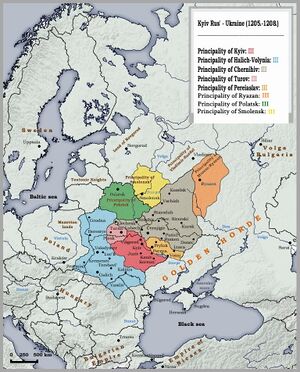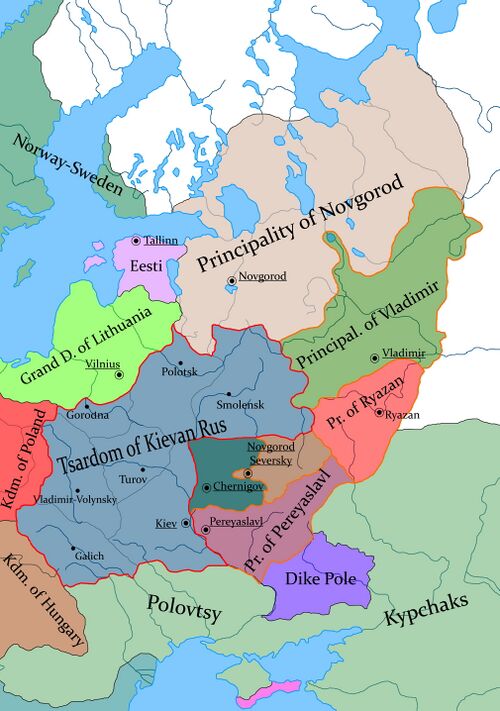Kiewan Rus: Difference between revisions
| Line 72: | Line 72: | ||
==Trade== | ==Trade== | ||
==Taxes (tribute)== | ==Taxes (tribute)== | ||
= | =States of Kievan Rus= | ||
[[File:Kievan Rus map.jpg|500px|thumb|right]] | [[File:Kievan Rus map.jpg|500px|thumb|right]] | ||
Revision as of 13:52, 18 May 2021
Tsardom of Kievan Rus Царство Київської Русі | |
|---|---|
| Capital and largest city | Kiev |
| Official languages | Old East Slavic |
| Recognised national languages | Old East Slavic Church Slavonic |
| Religion | Orthodox Christianity |
| Demonym(s) | Kievites |
| Government | Feudal absolute monarchy |
• Tsar | Daniel Romanovich from the Rurik dynasty |
| Legislature | Veche |
| History | |
• Established | 879 |
• Conquest of Khazar Khaganate | 965–969 |
| 988 | |
| early 11th century | |
| Area | |
• Total | 582,168 km2 (224,776 sq mi) |
• Water (%) | 6.1% |
| Population | |
• 1205 estimate | ~6,000,000 |
| Currency | Grivna (₴) |
Kievan Rus or Tsardom of Kievan Rus (Old East Slavic: Роусь, romanized: Rusĭ, or роусьскаѧ землѧ, romanized: rusĭskaę zemlę, "Rus' land") was a loose federation of East Slavic and Uralic peoples in Europe from the late 9th to the mid-13th century, under the reign of the Rurik dynasty, founded by the Varangian prince Rurik. At its greatest extent, in the mid-11th century, it stretched from the White Sea in the north to the Black Sea in the south and from the headwaters of the Vistula in the west to the Taman Peninsula in the east, uniting the majority of East Slavic tribes.
According to Rus Primary Chronicle, the first ruler to start uniting East Slavic lands into what has become known as Kievan Rus' was Prince Oleg (879–912). He extended his control from Novgorod south along the Dnieper river valley to protect trade from Khazar incursions from the east, and moved his capital to the more strategic Kiev. Sviatoslav I (died 972) achieved the first major expansion of Kievan Rus territorial control, fighting a war of conquest against the Khazars. Vladimir the Great (980–1015) introduced Christianity with his own baptism and, by decree, extended it to all inhabitants of Kiev and beyond. Kievan Rus reached its greatest extent under Yaroslav the Wise (1019–1054); his sons assembled and issued its first written legal code, the Russkaya Pravda ("Rus' Justice"), shortly after his death.
The state began to decline during the late 11th century, disintegrating into various rival regional powers. It was further weakened by economic factors, such as the collapse of Rus' commercial ties to the Byzantine Empire due to the decline of Constantinople and the accompanying diminution of trade routes through its territory. However, in 1202 Roman Mstislavich, the Grand Duke of Galicia and Volhynia, became the Grand Duke of Kiev and from 1203 to 1205 he conducted campaigns of conquest against the Principality of Polotsk and Smolensk. After that, he was crowned Tsar of the Second Kievan Rus, laying the foundation for the reunification of the lost lands.
Etymology
During its existence, Kievan Rus' was known as the "land of the Rus" (Old East Slavic: ро́усьскаѧ землѧ, from the ethnonym Ро́усь; Greek: Ῥῶς; Arabic: الروس ar-Rūs), in Greek as Ῥωσία, in Old French as Russie, Rossie, in Latin as Rusia or Russia (with local German spelling variants Ruscia and Ruzzia), and from the 12th century also Ruthenia or Rutenia. Various etymologies have been proposed, including Ruotsi, the Finnish designation for Sweden or Ros, a tribe from the middle Dnieper valley region. According to the prevalent theory, the name Rus', like the Proto-Finnic name for Sweden (*Ruotsi), is derived from an Old Norse term for "the men who row" (rods-) as rowing was the main method of navigating the rivers of Eastern Europe, and that it could be linked to the Swedish coastal area of Roslagen (Rus-law) or Roden, as it was known in earlier times. The name Rus' would then have the same origin as the Finnish and Estonian names for Sweden: Ruotsi and Rootsi.
In the Norse sources, the sagas, the principality is called Garðariki, and the peoples, according to Snorre Sturlason, are called Suiones, the confederation of Great Sviþjoð (Þjoð means people in Norse) were made up of the peoples along the Dniepr called Tanais that separated Asia and Europe (called Enea by Snorri Sturluson), all the way to the Baltics and Scandinavia.


